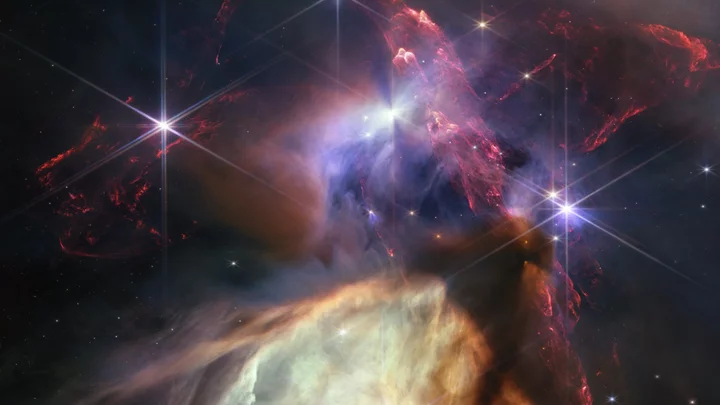NASA has released a new James Webb Telescope image to mark an important anniversary — and this time it shows the birth of stars.
On Wednesday, to celebrate a full year of science operations with the Webb telescope, NASA released a photo of the Rho Ophiuchi cloud complex, the closest star-forming region to Earth containing roughly 50 young stars. Behold:
Credit: NASA, ESA, CSA, STScI, Klaus Pontoppidan (STScI)The image gives an unprecedented textured view of the dual jets firing out of the young stars, while the image's lower half reveals a glowing dust cloud. The Rho Ophiuchi cloud complex, which you can also see via a video tour on NASA's website, is 390 light years away.
SEE ALSO: Webb telescope's photo of Saturn looks really weird. Here's why.The James Webb telescope – an incredibly powerful space observatory orbiting a million miles from Earth – has given us a range of spectacular images in recent weeks. It has allowed astronomers to peer at some of the first galaxies ever formed, has located the most distant supermassive black hole ever found, and detected crucial carbon molecules in the Orion Nebula.
NASA announced its plans to celebrate the Webb telescope's first full year of discoveries in a video posted on Tuesday.
"We're getting ready to mark the first year of spectacular discoveries from @NASAWebb," reads the tweet. "The space telescope has transformed the way we see the universe."
A link to a scheduled YouTube Q&A was also shared, where people will have the opportunity to put their questions to NASA experts. The session starts at 4pm ET on July 12.
Featured Video For You The Webb Telescope finally shows us Uranus' glorious ringsThe Webb telescope's powerful abilities
The Webb telescope — a scientific collaboration between NASA, the ESA, and the Canadian Space Agency — is designed to peer into the deepest cosmos and reveal unprecedented insights about the early universe. But it's also peering at intriguing planets in our galaxy, and even the planets in our solar system.
Want more science and tech news delivered straight to your inbox? Sign up for Mashable's Light Speed newsletter today.
Here's how Webb is achieving unparalleled feats, and likely will for decades:
Giant mirror: Webb's mirror, which captures light, is over 21 feet across. That's over two and a half times larger than the Hubble Space Telescope's mirror. Capturing more light allows Webb to see more distant, ancient objects. As described above, the telescope is peering at stars and galaxies that formed over 13 billion years ago, just a few hundred million years after the Big Bang.
"We're going to see the very first stars and galaxies that ever formed," Jean Creighton, an astronomer and the director of the Manfred Olson Planetarium at the University of Wisconsin–Milwaukee, told Mashable in 2021.
Infrared view: Unlike Hubble, which largely views light that's visible to us, Webb is primarily an infrared telescope, meaning it views light in the infrared spectrum. This allows us to see far more of the universe. Infrared has longer wavelengths than visible light, so the light waves more efficiently slip through cosmic clouds; the light doesn't as often collide with and get scattered by these densely packed particles. Ultimately, Webb's infrared eyesight can penetrate places Hubble can't.
"It lifts the veil," said Creighton.
Peering into distant exoplanets: The Webb telescope carries specialized equipment called spectrometers that will revolutionize our understanding of these far-off worlds. The instruments can decipher what molecules (such as water, carbon dioxide, and methane) exist in the atmospheres of distant exoplanets — be it gas giants or smaller rocky worlds. Webb will look at exoplanets in the Milky Way galaxy. Who knows what we'll find?
"We might learn things we never thought about," Mercedes López-Morales, an exoplanet researcher and astrophysicist at the Center for Astrophysics-Harvard & Smithsonian, told Mashable in 2021.
Already, astronomers have successfully found intriguing chemical reactions on a planet 700 light-years away, and the observatory has started looking at one of the most anticipated places in the cosmos: the rocky, Earth-sized planets of the TRAPPIST solar system.









